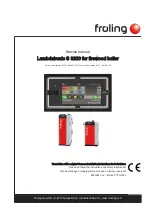
Technical documentation
Technical documentation
STZS ed. 06/03
24
ZEUS SUPERIOR
The circulation of water results in the closing of the pump pressure switch (SP) which, because it is connected
in series to the NC contact of the flue pressure switch (SV) powers the coil of relay “K5”.
If the temperature detected by means of NTC central-heating sensor (NR) is below that set by means of
the central heating potentiometer of the remote control (CAR), the adjustment circuit excites relay “K5”
and starts the fan (MV) controlled by relay “K1”.
The consequent deviation of the contact of the flue pressure switch (SV) results in relay “K4” being
powered and the relevant contact closing.
This powers the control unit (IGN. UNIT) and starts the ignition cycle, which continues in the same way
as the central-heating request with room thermostat.
Once the flame has been detected, the signal to the modulation coil is changed in a manner directly
proportionate to the difference between the boiler and room temperatures set and detected and, if
necessary, reaches maximum set value in 50 seconds
(maximum central-heating output).
When the set value is exceeded, the contact of relay “RT” is opened with consequent switch-off of the
burner.
Re-ignition of the burner for the same request remains inhibited for 180 s / 30 s.
Domestic hot water request
If the temperature read by the NTC sensor on the storage tank (NB) is below that set by means of the
d.h.w. potentiometer (D.H.W.), the low-voltage circuit starts the pump (MP) by means of relay “K2 and
powers the motor (M) of the 3-way valve (VD) through contact of relay “K3”.
Following consequent closing of pump (SP) pressure microswitch, burner ignition proceeds in the same
way as for central-heating phase.
Flame modulation occurs with reference to the flow temperature read by the central-heating sensor (NR)
which is changed according to the difference between the temperature set by means of the d.h.w.
potentiometer (D.H.W.) and that measured by the d.h.w. sensor (NB).
When the temperature measured by the d.h.w. sensor (NB) exceeds that requested, the contact of relay
K4 is opened and after post-operation times also the contacts of relays “K2”
(pump)
and “K1”
(fan).
When the temperature drops again, the relays are once again powered to start the new ignition cycle.
If, during operation, the heating sensor. (NR) measures a flow temperature higher than 87 ºC, the contact
of relay K4is opened. This is closed again just as soon as the temperature drops to 75 ºC.
Central-heating antifreeze request
With the main switch (IG) in SUMMER or WINTER position, if the temperature read by the NTC central-
heating sensor falls below 4 ºC, the board allows ignition in central-heating mode and keeps the boiler
operating with the burner at minimum output until a boiler temperature of 42°C is reached.
Domestic hot water request
With the main switch (IG) in SUMMER or WINTER position, if the temperature read by the NTC d.h.w.
sensor (NB) falls below 4 ºC, the board allows ignition in d.h.w. mode and keeps the boiler operating with the
burner at minimum output until the d.h.w. (NB) sensor reads a temperature of 8°C.
During operation, the water in the primary circuit remains below 42°C because when such temperature is
reached, the board switches off the burner.
“Chimneysweep” request
When the reset button (PU1) is pressed for at least 10 seconds, as soon as this is released, the board gives the
signal for boiler ignition and keeps this operating in central-heating mode at max heating output for 15
minutes.
In this phase, only the limit thermostat function is operative
(90 ºC)
performed by the central-heating sensor.
The function is only engaged if there are no requests under way for central-heating, domestic hot water or
antifreeze and it is indicated by means of code "7" on the display panel and by the flashing of central-heating
(DL1) and d.h.w. (DL2) LEDs.
It can be interrupted by cutting power to the circuit.









































